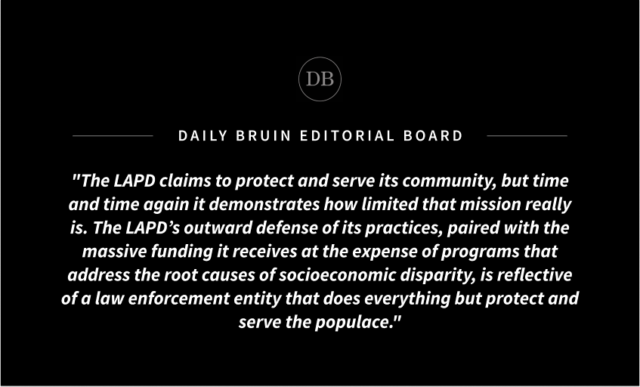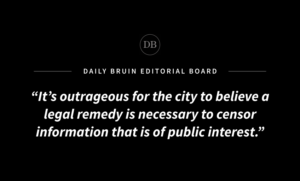This post was updated Oct. 5 at 7:07 p.m.
The LAPD has blood on their hands as Black and Latino people continue to be senselessly killed by police violence.
The disproportionate targeting of marginalized communities by law enforcement has a shameful historical precedent. The murder of George Floyd in 2020 exposed the world to a harsh reality of what the United States has always been. But instances of law enforcement’s brutality are more frequent than they are reported in the mainstream media.
Law enforcement’s infamous promise to “protect and serve” has historically never been afforded to all populations, with their origin tracing back to the slave patrol in the Antebellum Period. The policing institution has never been broken – it’s functioning exactly in the way it was originally designed.
A recent LAPD arrests map found concrete evidence between 2019 and 2022 that Black and Hispanic/Latino people are disproportionately arrested compared to their white counterparts. Despite Black and Hispanic/Latino individuals comprising 56% of the Los Angeles population, they made up about 78% of all arrests during the period. This systemic issue is not only racialized but reflects targeting based on socioeconomic status as well.
This comes as no surprise given the racial profiling history of the LAPD. Thus, it is imperative to remain critical of the state-sanctioned racial violence that has been ingrained in the institution from its inception.
Following the release of the arrest data, the LAPD responded in a statement defending the disparities in the arrest rates, arguing that Black and Hispanic Angelenos were overrepresented as both the principal victims and alleged perpetrators of violent crime.
The statement continues by arguing that the statistics themselves do not necessarily show decisive evidence of racial bias in policing, stating, “significant other factors such as the roles of poverty, education, and under-resourced communities have critical implications.”
This response fails to meaningfully justify the disproportionate rates of arrests among different racial groups. In fact, the statistics on the perpetrators of violent crime it cites are themselves a product of biased policing.
According to the California Department of Justice’s OpenJustice database, the LAPD made an arrest – unless an arrest of a suspect became impossible – in about 73.6% of homicide cases but only 41% of violent crimes in 2022.
If less than half of violent crimes reported to the LAPD result in an arrest, it’s possible the statistical disparities the response cites are themselves partially a product of biased policing, with higher arrest rates for people of color who allegedly committed violent crimes being closely tied to the overpolicing of communities of color.
The LAPD’s statement also fails to mention racial disparities in the arrest rates for misdemeanors and infractions, which comprised more than half of all arrests from 2019-2022 and represented a staggering 63% of arrests in 2019 alone.
It’s difficult to believe that an allegedly higher rate of violent crime would also substantially affect the arrest rate for misdemeanors or infractions, especially when recent historical trends clearly show the statistical effects of bias in how they are policed.
Studies have repeatedly shown that white and Black people engage in recreational marijuana use at similar rates. In a 2020 report, updating the findings of an earlier 2013 report, the ACLU found that Black Americans were 3.64 times more likely on average to be arrested for marijuana possession in 2018.
While California reduced the criminal penalties for marijuana possession in 2011 and legalized it in 2016, these racial disparities were still evident before those legislative changes. In 2010, according to the 2013 ACLU report, Black people in LA County were nearly 2.6 times more likely to be arrested for marijuana possession than white people, a rate above the state average but below San Francisco and Sacramento counties, where the arrest rates had even greater disparities between racial groups.
Despite recent legal and legislative efforts to legalize drugs like marijuana and reduce sentencing disparities, the war on drugs is emblematic of the ways that people of color have been disproportionately targeted by police in LA and elsewhere.
The concerns that the LAPD expressed relative to the “critical implications” of access to community resources on the arrest data must also be considered in light of the fact that the LAPD’s current annual budget of $3.2 billion – set to rise to $3.6 billion in 2027 under Mayor Karen Bass’ plan to increase police hiring – represents a massive amount of the city’s funding.
That funding could instead be allocated to provide resources and education for these underserved communities, which would address the factors that the LAPD explicitly presented as the cause for the racial disparities in arrests.
The LAPD claims to protect and serve its community, but time and time again it demonstrates how limited that mission really is. The LAPD’s outward defense of its practices, paired with the massive funding it receives at the expense of programs that address the root causes of socioeconomic disparity, is reflective of a law enforcement entity that does everything but protect and serve the populace.
The new arrest data is not shocking. It confirms what many already knew was true. The data is just another potential piece of evidence showing the persistence of systemic racism within the LAPD long after it was clear it needed to change.





Comments are closed.